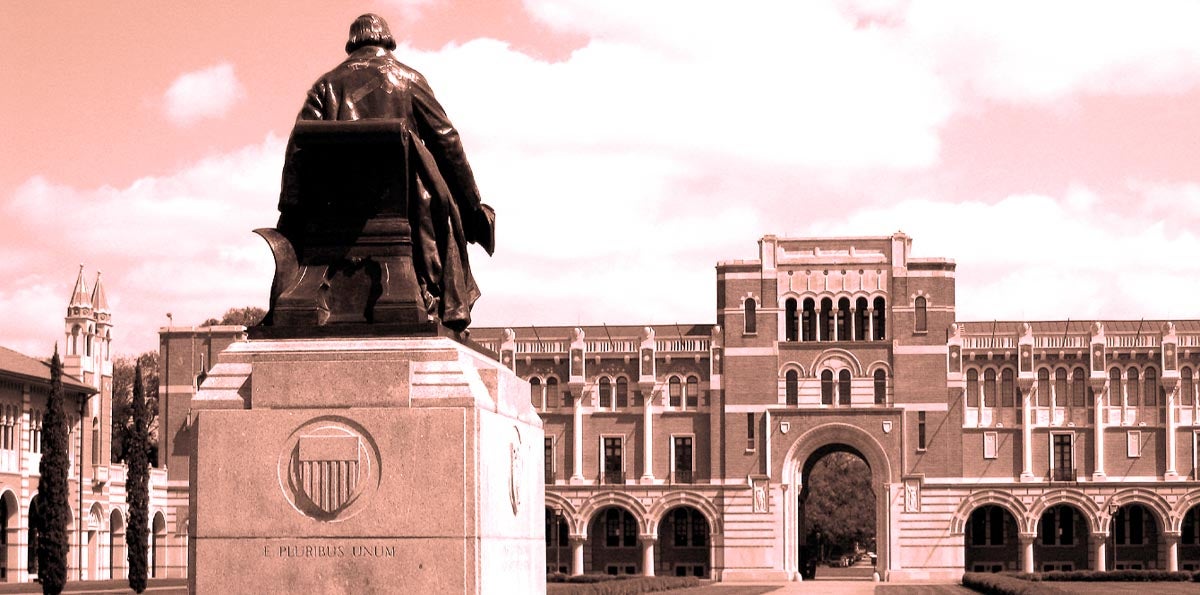Since the death of George Floyd, the United States has been in nothing short of a reckoning with systemic racism — a reckoning that has, in part, focused on how we remember our past. We are witnessing the removal and, in some cases, outright toppling of statues commemorating the Confederacy.
Even here in Houston, students at Rice University are asking for the statue of William Marsh Rice — the university’s founder and a slave owner — to be removed. The statue is featured prominently on the Rice campus.
This moment, however, is not new.
Five years ago, in the wake of the racially motivated mass shooting in Charleston, South Carolina, that left eight African American parishioners dead, we saw similar calls to action. Some places heeded that call — the Confederate battle flag flying over the SC state capitol came down; monuments in Baltimore were contextualized and later removed — but most ignored it. Worse, others responded by erecting new Confederate monuments.
So, here we are, again. Returning to a familiar and difficult conversation. However, this time we carry even more baggage because we chose not to make changes five years ago. We chose to let the moment pass. We cannot afford to do that again.

Monuments: A much-needed conversation
Why talk about this at all? Why does the removal of Confederate monuments remain in public conversation?
Monuments are not just hunks of rock. They are symbols of who we — as a society — are. They are designed to inspire emotion and recall a shared history.
That’s where Confederate monuments fall short.
Confederate monuments are tied to a divisive history. They do not inspire unity. In fact, they celebrate rebellion. They offer comfort to some (white Southerners who view the confederacy as a key part of their heritage), but they exclude (white non-Southerners) and outright reject (Black Americans) others.
The denial of the Black American experience is clear through the inscriptions on some of the monuments.
In Centreville, Alabama, the United Daughters of the Confederacy described their “Confederate heroes” using the following text:
“These were men who
by the simple manhood of
their lives,
by their strict adherence
to the principles of right,
by their sublime courage
and unspeakable sacrifices,
even to the heroism of death
have preserved for us
through the gloom of defeat,
a priceless heritage of Honor.”
“It is a duty we owe to
posterity to see that
our children shall know
the virtues and become
worthy of their sires.”
Historians are clear on the fact that the Civil War was not motivated by states’ rights. It was motivated by a desire to preserve the status quo and continue enslaving Black Americans. To lavish praise on those who fought for the Confederacy and leave prominent monuments honoring their cause is to deny the brutal reality of the people who were enslaved.
Still, some may argue that the past is the past and it has no bearing on today. Research suggests otherwise. More than merely testimonies to the past, the division and inequality that slavery began remains steadfastly part of our day-to-day.
We see this in the higher levels of inequality between Blacks and whites in places where slavery was more concentrated. Research demonstrates this relationship for poverty, school segregation, use of the death penalty, health outcomes and more.
We see this again when thinking more broadly about the ways we understand race and identity. Anti-miscegenation laws legalized racial boundaries, but were abolished in 1967. Despite their removal, people who live in or were born in states that had these laws — Texas among them — are more likely to make racial classification decisions that reflect the continued existence of those boundaries.
Parents of Black/white biracial children are least likely to report their child’s race as “Black and white” on the census, and are more likely to opt for “Black alone” in states where the history of anti-miscegenation law is stronger.
Finally, if that were not enough, there is even evidence that Confederate monuments are related to higher levels of Black-white inequality. An experimental study examining voting behavior further demonstrates that there are real consequences to keeping Confederate symbols in public spaces: people who were primed — or subconsciously saw — a Confederate battle flag reported being less willing to vote for Barack Obama and higher levels of anti-Black attitudes.
Our history matters, and the way that we remember the Confederacy is an important part of that history.
Options for moving forward
There are many sides to this debate, and a corresponding list of actions to take.
Some demand the Confederate monuments remain. They voice concern over a loss of heritage and argue that removing a monument accomplishes nothing.
Others want them gone.
A compromise proposes adding plaques to contextualize the monuments and explain their origins. However, this option ignores the importance of placement. No amount of words can alter the signal that is sent by these monuments being positioned in a place of prominence. Leaving them where they stand suggests that they — and the history they represent — are important.
But if we remove them outright, we run the risk of both forgetting the role they played and why their removal was called for in the first place. Removing them and doing nothing more masks the underlying systemic racism that supported their initial placement on public property.
Recent evidence shows that placing monuments within a museum designed to educate the public on their racist legacy allows the audience to view them as a signal of the work that still needs to be done. Forthcoming research by Christina Simko, David Cunningham and Nicole Fox suggests that places that accomplish this are in a better position to maintain meaningful conversations about inequality, even after the monument is removed.
A final, complementary option to consider is the addition of a new monument. Erecting new statues or replacing names on buildings serves to expand who we honor and how we see our history. Monuments dedicated to this historical moment — the year we came together during a global pandemic to fight for equality, for life — could be a truly inspirational and uniting public symbol.
Our take
It is clear that action is needed to address our public landscape. And not just Confederate monuments. But we want to close with a cautionary reminder:
Ultimately, the issue of monuments and names is a symbolic one. Removing a monument or renaming a building are steps toward using symbols that better reflect shared values of equity and inclusion. However, more is needed to address the systemic racism and institutional discrimination that is at the root of the issue.
Removal may be symbolic, but it can jump-start a conversation and help us move forward on structural change. The fact is, if we can’t remove a monument, how are we going to tackle bigger changes?
Heather O’Connell is a professor of sociology at Louisiana State University. She is a former Kinder Institute fellow.
Jenifer Bratter is an associate professor of sociology at Rice University and director of the Kinder Institute’s Program for the Study of Ethnicity, Race and Culture.

